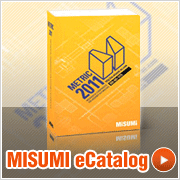#141 Low Cost Automation and Quality - 4: Component Mounting Automation and Quality
Products that require electronic controls, including consumer electrical appliances, all include some sort of electronic printed circuit boards ([Photo]).
-During the period when the Japanese assembly industries advanced towards overseas, there was a time where many of the PC board production lines have adopted manual assembly workers in production lines, though assembly automation has already been realized in Japan.
-Since the labor costs were low in those locations where the Japanese businesses have advanced at that time, the production lines were designed and constructed based on a concept of "errors would be eliminated at inspection process stages".
-However, the manual inspections could not completely eliminate inspection misses due to human labor nature, even as the inspections were re-inspected, and zero defects was never accomplished.
-On the other hand, automated mounter can (1) inspect mounted parts, (2) confirm mounting positions, (3) check the soldering conditions, and (4) inspect functionalities of the PC boards, and incidence of failure can be kept to ppm order.
-This, however, is stipulated on a precondition that the automated mounter is properly maintained (especially the preventative maintenance).
-Based on the two production methods mentioned above, also with the limitations of manual labor, low cost automation has gradually progressed into the oversea advancements.
-It is difficult for automated machines to process while determining the instabilities in shapes and performances of the parts handled. Conversely, the advantage of skilled workers is able to overcome such shortcomings of automated machines.
-Therefore, the abilities of skilled workers are useful for prototypes during the early stages of new product development, where as for the mass production phase is the turn for the automated machines.
-For high density mounted components, human operations are difficult even for the early stage prototypes. Low cost automation not prioritizing the process speeds will be needed.
![[Photo] Example of an electronic circuit board [Photo] Example of an electronic circuit board](http://www.misumi-techcentral.com/tt/en/lca/images/145_01.jpg)
- Positioning technology
- Designing and processing
- Sensor Technology
- Automation elements technology
- Clean room technology
- Design hints
- Design tips
- Designing and Machining
- Drive mechanism design
- Hints on designing
- Linear Motion Components
- Locating Technology
- Manufacturing technology
- Motion mechanism design
- Pneumatic Drives
- Production Technology
- Technology Outlook
- General description
- Low-cost automation and materials
- Transfer LCA
- #333 Know-how on automation: Pressurized heating technology - 5: Multilayer pressurized heating process technique
- #332 Know-how on automation: Pressurized heating technology - 4: Points to remember when designing mechanism of pneumatic pressurization method
- #331 Know-how on automation: Pressurized heating technology - 3: Pneumatic pressurization method and pressure profile
- #330 Know-how on automation: Pressurized heating technology - 2: Pressurization method and pressure profile
- #329 Know-how on automation: Pressurized heating technology



